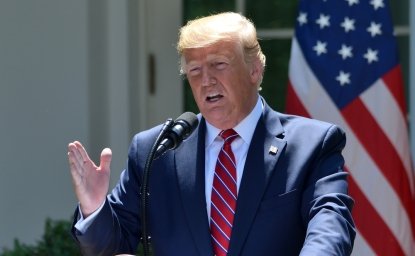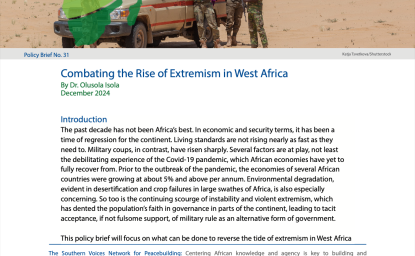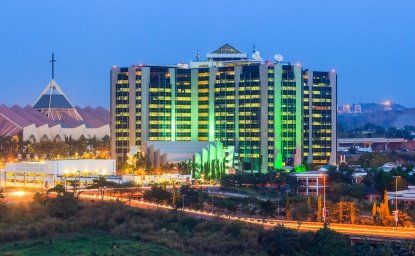On February 27, General Joseph Votel, commander of U.S. Central Command (CENTCOM), warned the House Committee on Armed Services that violent extremist organizations are one of the most "grave challenges" CENTCOM faces in its area of operations today. "The violent extremist ideologies of ISIS, al-Qa’ida (AQ) and other VEOs remain a threat to the United States and our allies and partners, not just in the CENTCOM region but worldwide," Votel said during the hearing. He announced a strategy shift to focus on combatting ISIS in Southeast and Central Asia, while simultaneously stabilizing and "consolidating gains" in Iraq and Syria. The following are excerpted remarks from General Votel's prepared testimony.
Introduction
Our Global Coalition to Defeat ISIS and partners, in particular the Iraqi Security Forces (ISF) and Syrian Democratic Forces (SDF), have made extraordinary progress for over three years, liberating Mosul and Raqqah—the former capitals of ISIS’s self-proclaimed “caliphate.” Now, more than 98% of the territory in Iraq and Syria formerly held by ISIS is no longer under their control.
Every day, our military and civilian personnel, forward deployed across the region, conduct training exercises and strengthen our partners’ abilities to defend themselves from external threats and challenge violent extremism within their borders.
Our success over the last year is largely due to the unyielding support of our allies, tremendous cooperation with our interagency partners, provision of additional authorities, and the continued faith of the American people in our military. However, despite the great strides we have made, there is much work left to do. The challenges in the region are many: terrorism, violent conflicts, massive refugee populations, economic stagnation, social upheaval, great power competition, nuclear and ballistic missile threats, humanitarian crises, and radical violent ideologies to name a few. As our country begins to shift focus to threats in other parts of the world, the CENTCOM region remains vital to United States’ security and economic interests. We will continue to ensure our nation’s resources are responsibly employed to protect the American people from terror, promote American centers of trade and prosperity, and preserve peace through strength to deter future conflicts.
CENTCOM's Challenging Environment
The CENTCOM area of responsibility stretches from northeast Africa, across the Middle East, to Central and South Asia. The twenty countries within this vast region confront profound social, economic, and political upheaval while simultaneously facing grave security challenges in the form of widespread conflict, expansionist regional powers, violent extremist organizations (VEOs), and destabilizing behavior from outside actors.
Violent Extremism. The violent extremist ideologies of ISIS, al-Qa’ida (AQ) and other VEOs remain a threat to the United States and our allies and partners, not just in the CENTCOM region but worldwide. Although ISIS has steadily lost control over physical territory and no longer controls any major population centers in Iraq or Syria, Sunni populations remain vulnerable to identity-based recruitment into VEOs. Violent extremists have utilized online forums to spread violent interpretations of Islam to audiences across the globe. The impressionable youth in this tumultuous region, seeking community and justice, are highly susceptible to extremists’ teachings; consequently, a new generation of radicalized followers could become online citizens of a “virtual caliphate,” dedicated to the struggle against the West.
Both ISIS and AQ are resilient and have proven capable of projecting propaganda and inspiring attacks throughout the region and outside of the Middle East. In Egypt, ISIS has expanded its reach into the mainland and carried out mass-casualty attacks. ISIS-Khorasan (ISIS-K) continues to orchestrate high-profile attacks in Afghanistan. Al-Qa’ida in the Arabian Peninsula (AQAP) continues to plan attacks on the homeland from the ungoverned spaces in Yemen.
Proxy Warfare. The Central Region has a long history of proxy warfare, violent militias, and irregular forces operating in the “grey zone” – military competition short of war. Iran has extended its tentacles across the region through numerous proxies, including Lebanese Hizballah operating in multiple countries, hardline Iranian-backed Shia Militia Groups (SMGs) in Iraq and Syria, and Iranian support has enabled the Houthis. The result is prolonging the civil war in Yemen, threatening Saudi Arabia and the UAE, and risking expansion of Yemen’s civil war into a regional conflict. Iran uses its proxies to secure supply lines for malign activities and influence neighboring governments.
Nuclear/Ballistic Missile Proliferation. Regional conflicts and power imbalances drive nations to seek and acquire nuclear weapons and extend ballistic missile capabilities to secure their influence. As an example, Iran continues to develop advanced ballistic missile capabilities and also transfer them to the Houthis and to its Hizballah proxies.
Regional Competitors. The competition between Iran and Saudi Arabia for influence in the region exacerbates multiple security dilemmas throughout the Middle East – from Iran’s support of Houthis in Yemen, to Riyadh’s attempt to diminish Hizballah’s authority in Lebanon. Iran is also working through proxies and friendly political allies in Iraq, Syria, and Lebanon to establish an arc of influence, or “Shia Crescent” across the Middle East.
Prepare - Pursue - Prevail
CENTCOM’s mission is to direct and enable military operations and activities with allies and
partners to increase regional security and stability in support of enduring U.S. interests. We aim to accomplish this mission through our strategic approach of “Prepare, Pursue, Prevail.” This approachaligns with the recently published National Defense Strategy (NDS), which directs us to “Compete, deter, and win in conflict and reinforce all levers of national power from sustainable positions of military advantage.” It also aligns with the POTUS-approved strategies for Iraq and Iran. These strategies look to consolidate gains achieved through defeating ISIS, while neutralizing and countering Iran’s destabilizing influence, and ensuring a stable Iraq does not align with Iran and remains a productive strategic U.S. partner.
CENTCOM Priorities
With ISIS’s territorial control crumbling in Iraq and Syria, we have shifted our main effort to implementing the military component of the South Asia Strategy in Afghanistan through OFS and NATO’s noncombat RSM, while still retaining sufficient resources to enable local security forces to prevent the reemergence of ISIS in Iraq and Syria.
Countering Violent Extremist Organizations. Another critical objective from the NDS is to prevent terrorists from directing or supporting external operations against the U.S. homeland, allies, and partners. In the past year, Operation INHERENT RESOLVE has achieved remarkable success against ISIS in Iraq and Syria. ...The destruction of ISIS’ so called physical “caliphate” is imminent, but now we must consolidate gains by investing in the population that will hold this territory and keep ISIS from returning.
The Coalition’s campaign to defeat ISIS has had considerable success. Coalition airstrikes have killed hundreds of ISIS leadership figures and facilitators in Iraq and Syria, which has disrupted ISIS’ command and control network; degraded its use of unmanned aerial systems (UAS); reduced its ability to conduct research and development, procurement, and administration; and denied sources of funding for terrorist activities. These losses have undermined ISIS’ ability to conduct attacks throughout the region and the world. With the loss of terrain and the liberation of the population, ISIS can no longer generate funding through extortion and taxation. Additionally, airstrikes and ground operations have crippled and seized hydrocarbon generating facilities and facilitation routes that moved and supplied ISIS fighters and supported illicit oil sales. We have also degraded ISIS media operations; the most recent version of their monthly online terror magazine “Rumiyah” was last published in September 2017.
In Iraq, the ISF fought a vicious, urban battle to liberate Mosul, with ISIS providing stiff resistance using tunnels, vehicle-borne improvised explosive devices (VBIEDs), and unmanned aerial systems. The liberation of Mosul provided the ISF with the momentum that led to the quick liberation of Tal Afar and Hawijah. Our partnership with the ISF is an excellent example of the successful application of the “by, with, and through” approach. Using a minimal number of U.S. and Coalition advisors, we enabled the ISF with robust communications, logistics, intelligence, and precision fires. Iraqi forces led from the front in each operation, and their success elevated their legitimacy with the population.
ISIS’ reversion to an underground insurgency will remove the greatest unifying factor among Iraq’s competing factions and may reignite unresolved grievances. In the post-ISIS period, the GoI will be challenged to rebuild Sunni areas while balancing competing security demands, enacting government reforms, and managing tensions among Iraq’s political factions.
In Syria, the fight against ISIS has been complicated by the multiple countries involved in the conflict, many of whom have widely divergent interests. Syrian President Bashar al Assad remains in power, and, due to military support from Russia, Iran, and Lebanese Hizballah (LH), is attempting to bring all of Syria under regime control. In 2017, the regime made significant territorial gains in central and eastern Syria, culminating in reducing opposition enclaves in western Syria and seizing urban centers from ISIS along the western bank of the Euphrates River from ISIS. Nevertheless, the Assad regime has insufficient forces to adequately secure recaptured territory and often faces insurgent counterattacks behind its lines.
For the Coalition, the SDF’s liberation of ISIS’ capital Raqqah in October 2017 was a significant turning point in the conflict. The SDF, which is composed of local Sunni Arabs and Kurds, has been a valuable partner in the fight against ISIS, and they sacrificed greatly to liberate large portions of their country. Simultaneous operations by the SDF in Syria and the ISF and PMF in Iraq effectively isolated ISIS remnants in the Middle Euphrates River Valley (MERV) and along the Syrian side of the Iraq-Syria border where both forces are currently conducting operations to kill or capture all remaining ISIS fighters.
Pro-Regime Forces (PRF) and Russia also continue to operate in the MERV as they isolate ISIS fighters south of the Euphrates River, though Assad’s decision to prematurely withdraw his forces has likely given valuable breathing room to ISIS on the western side of the river. With PRF operating in close proximity to Coalition-backed forces in the MERV, de-confliction measures are vital, and we have worked closely with Russia to prevent accidental strikes and to ensure the safety of the various forces on an increasingly complex battlefield.
Amidst the visible damage caused by the Syrian civil war, the country has also witnessed a far less-publicized change: democratic organizations in the form of local civil councils have assembled in places previously controlled by ISIS. ... These ad-hoc democratic organizations come in various forms and engage in a range of activities from providing the most basic services to rallying the population against the re-emergence of VEOs. For example, in the cities of Manbij and Raqqah, local councils ran civic campaigns against ISIS in concert with more moderate rebel groups, providing a two-pronged strategy that ultimately prevented ISIS from regaining a foothold in these areas.
A significant challenge we face as we complete the defeat of ISIS is the repatriation of hundreds of foreign fighters to their home countries. The SDF and ISF are both holding several hundred fighters from a number of different countries in prisons or temporary detention facilities, with no clear process for prosecution or repatriation. The longer these fighters remain in detention together, the greater danger they pose as they form new connections, share lessons learned, and prepare to re-establish networks upon their release or escape. This urgent problem requires a concerted international effort involving law enforcement, intelligence sharing, and diplomatic agreements.
Yemen. Houthi forces control Yemen’s capital, Sana’a, and are undeterred in their efforts to retain key territory and attack the Saudi coalition. The civil war has severely affected Yemen’s population, with nearly 80% of the population requiring urgent humanitarian assistance. Similarly, its economy has been devastated by insecurity, extremely high unemployment (35%) and near cessation of its petroleum industry. Neither the Houthis nor the exiled Hadi government has the ability to govern effectively. In December 2017, the relationship between previously aligned Houthis and former President Ali Abdullah Salih disintegrated and culminated with Salih’s assassination by his former allies. It is unclear if the Saudi-backed Hadi faction can capitalize on these events, and Salih’s forces have splintered, adding continued chaos.
Terrorist groups like AQAP and ISIS-Yemen continue to maintain a presence in Yemen and are focused on attacks against ROYG, the Saudi coalition, and Houthi targets. Since mid-2014, ISISYemen has leveraged the chaotic security situation to expand its capabilities and conduct intermittent attacks against Saudi coalition and Yemeni security targets in Aden. AQAP still aspires to threaten Western interests with high-profile attacks, although U.S. and Saudi coalition strikes have removed successive levels of leadership and logistics support, critically damaging their network. Our Emirati partners have also played a key role in countering the threat from AQAP and ISIS-Yemen in southern Yemen.
The conflict in Yemen has opened opportunities for Iran, which continues to provide support to the Houthis with the aim of building a proxy to pressure the Saudi-led coalition and expand its sphere of influence. This support enabled the Houthis to launch missiles at Saudi Arabian and Emirati cities and target ships in the Bab al Mandab and Red Sea on multiple occasions in the last year, threatening Americans and our partners and raising the risk of broader regional conflict.
CENTCOM is partnering with the Saudi-led coalition to help maintain a favorable regional balance. Our goal is to ensure that nations in close proximity to Yemen are able to secure their borders and safeguard their populations while negotiations lead to a cessation of hostilities between Houthis and the ROYG.
The Levant. The Levant, which includes the countries of, Syria, Israel, Jordan, and Lebanon – and Iraq and Egypt remain an active area for CENTCOM theater security cooperation and partnership due to instability stemming from the Syrian Civil War, the rise of ISIS, and malign Iranian influence. Though the scourge of ISIS is receding, Levantine countries remain under threat of attack, as seen in Egypt where ISIS-Sinai continues to carry out barbaric attacks against civilians and Egyptian security forces, including the November murder of over 300 citizens in prayer at a mosque in northern Sinai. U.S. assistance to our partners in the Levant has enabled improved border security in Lebanon and Jordan. The Lebanese Armed Forces (LAF) demonstrated this kinetically in August – expertly routing ISIS fighters on their eastern border during Operation Dawn of the Hills.
Lebanon. Wedged between a key friend in the region, Israel, and a corridor of Iranian influence from Tehran through Iraq and Syria, Lebanon has managed to remain relatively stable in a region embroiled in conflict. However, Lebanon faces a stagnant economy, a Syrian refugee crisis, and the growing influence of Hizballah, which holds a de-facto veto on Lebanese policy decisions due to their strategic political alliances, omnipresent threat of violence, strength as a social service provider, and financial support from Iran. Furthermore, the possibility of an Israel-Hizballah conflict is a constant threat to the stability of Lebanon and security of Israel.
Egypt. Egypt is an essential partner in countering the flow of foreign fighters, materiel, and financial support to extremists transiting from Libya through Egypt into the Central Region. Egypt supports our overflight requests, ensures Suez Canal transit, and shares our commitment to defeat ISIS.
ISIS-Sinai continues to conduct daily attacks against the Egyptian Armed Forces (EAF) and security services, causing hundreds of casualties, while other extremist organizations have carried out attacks on the mainland. The United States commitment to continuing to support Egypt in this fight against terrorism, in bringing security for the Egyptian people, is steadfast. Until now, the EAF has contained most of the violence in the northeastern Sinai Peninsula; however, without a comprehensive whole of government strategy to defeat ISIS-Sinai, the threat will persist and grow. The United States is committed to working with Egypt to develop a comprehensive counter-insurgency strategy that addresses the underlying political, economic, and social conditions that give rise to extremist elements, while defeating the threats that plague Egypt and the region.
United Arab Emirates. The UAE was among the first countries to join the Defeat-ISIS Coalition. Although its military role tapered off when its resources shifted to Yemen in March 2015, Abu Dhabi remains active in pursuing many of the Coalition's lines of effort, including counter-ISIS messaging, stabilization, countering ISIS financing, and stemming the flow of foreign fighters.
Bahrain. Defeat-ISIS effort, including allowing U.S. forces to conduct counter-ISIS strikes from its territory. In Yemen, Bahrain’s air, land, and sea forces participated in Saudi-led coalition operations against AQAP and the Houthis; these deployments have improved the overall readiness of the Bahrain Defense Force.
Qatar. Despite its small size, Qatar has contributed to coalition operations throughout the region, including against ISIS, and seeks to expand its participation in other regional coalitions.
Required Programs, Capabilities, and Resources
Building Partner Capacity (BPC). The Counter-ISIS Train and Equip Fund (CTEF), Afghan Security Forces Fund (ASFF), Combatant Commanders Initiatives Fund (CCIF), Coalition Support Fund (CSF), and Commander’s Emergency Response Program (CERP) have been key enablers to the battlefield successes the Coalition achieved in disrupting and dismantling ISIS and the Taliban. ...
In Syria, CTEF-procured equipment and supplies provided to the Vetted Syrian Opposition (VSO) like the SDF have been instrumental to their success against ISIS.
Intelligence, Surveillance, Reconnaissance (ISR) Assets. In addition to continued ISR requirements to enable our partners in Iraq, Syria, and Afghanistan, counter-Iran operations in Yemen, the Bab al Mandeb, and the Gulf place substantial ISR demands on already severely limited resources. We also anticipate additional requirements to assist Egypt in their counter-ISIS operations in the Sinai.
Information Operations/Strategic Communications. The ISIS problem set has enabled the Department of Defense to closely collaborate with other U.S. government agencies, Coalition partners, and regional allies to coordinate and synchronize messaging strategies. We are building on our combined experiences to create a broad, long-term, whole-of government approach that amplifies our efforts toward conflict prevention. We also routinely work with Iraq, Jordan, Kuwait, and Saudi Arabia to improve interoperability, share lessons learned, and ultimately develop a collaborative strategy to counter violent extremism – our regional partners will play the largest role in shaping their own futures.
As we work to address the propaganda that terrorist organizations use to recruit new followers, we must also address the serious threat that state-sponsored disinformation poses to U.S. national security. Amidst these trends in the information environment, it is more critical than ever that the U.S. government has a comprehensive, whole-of-government approach to strategic communication that supports and harmonizes with our military efforts.
Conclusion
CENTCOM remains the only geographic Combatant Command executing active combat operations. In the last year, we have made great strides toward defeating ISIS. This year we will shift our focus to the South Asia Strategy in order to push OFS toward a successful conclusion, while consolidating the gains we have made against ISIS, supporting our political and security objectives in the Gulf and Levant, and countering Iran. We must continue to degrade and destroy VEOs that threaten the safety of our citizens and partners by pursuing ISIS across the Central Region.
Click here to read the full statement.

The Islamists
Learn more about Hamas and how it relates to similarly aligned organizations throughout the region. Read more

Explore More
Browse Insights & Analysis
What Trump’s 2025 Inauguration Speech Says About US-Mexico Policy


